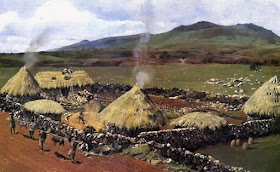Time. Date. Minutes and Days. Modern life is plagued by the
obsession of many who run their lives by logging minutes rather than living
moments. Were we to deposit these people into the 5th Century how
would they survive without clock-watching? At the time my novels are set (mid 5th
Century AD) there were no clocks, watches, laptops, television, radios – no
devices from which to discern the time of day. You looked at the arc of the sun
or moon, the respective orb in the sky denoting day or night. The world around
you - plants and weather - told you in which season you lived.
 |
| Celtic farmstead, North Wales c. 3rdC AD via timetrips.co.uk |
For the Celts, their calendar was pastoral and linked to the
turning wheel of the year, its repeated cycles of birth-growth-death as foliage
sprang forth, bloomed and died back. Rural farming communities are slaves to
these changes even today. The first ploughing begins at the start of February
when the ground is warmer and softer following ‘cold-time’ (December/January)
and lambs are born, which perhaps is why January-February was known by the
Celts as ‘Anagantios’ (stay-home time). No point jetting off on that late
winter-sun holiday when all the pregnant sheep are about to drop!
 |
| Celtic coin showing image of wheat, via resourcesforhistory.com |
Every stage of the year was mapped by the events of nature
and requirements of the farming community. To glean how important it was to the
Celts, we need only look at archaeology. Farming was central to the lives of
farmers and as such, made it onto coins of the time as can be seen from the
cunobelinus coin shown above. We know the Celts kept calendars, though they are
not as recognisable as the Roman Julian calendars we take for granted today,
with numbered days of weeks, fortnights and 30 or 31 day months (with the
obvious exception of February!). They were, however, sectioned into twelve
segments throughout the pastoral year as follows:-
Jan/Feb Anagantios Stay-home
time
Feb/Mar Ogronios Ice
time
Mar/Apr Cutios Windy
time
Apr/May Giamonios Shoots-show
May/Jun Simivisonios Bright
time
Jun/Jul Equos Horse
time
Jul/Aug Elembiuos Claim-time
Aug/Sep Edrinios Arbitration-time
Sep/Oct Cantlos Song-time
Oct/Nov Samonios Seed-fall
Nov/Dec Dummanios Darkest
depths
It is evident from the Celtic meanings how our ancestors
viewed the world around them and how entrenched in the natural sways of the
earth their lives were. If we consider these unfamiliar-sounding names such as
‘Samonios’, the name itself does not immediately provide us with any
understanding of that ‘month’. If we look at its meaning, however, we can
identify with ‘Seed-fall’ around October/November, as we see it ourselves at
this time of year. Trees and plants shed leaves and seeds and gardeners store
tubers for the following spring. This makes sense to our modern minds. What may
not make sense would be how the Celts
noted down their calendars. As well as using their own language, they used
their own text, known as ‘ogham’. The ‘ogham’ alphabet is based upon the woods
of different trees connected with the various times of the year. Similar to
runes, they appeared as vertical and horizontal bars of varying numbers.
 |
| Celtic tree calendar, via ogham.thewahzone.com |
So, I’m staying home this Anagantios, at least until
Ogronios is over. By then, as they say in Breton, Nevez-amzer will be here (new
season/spring). Then just as I plan to do some serious gardening the winds
arrive, darn that Cutios!
~~~~~~~~~~~~~
~~~~~~~~~~~~~
Elaine writes historical fiction as 'E S Moxon'. Her debut Wulfsuna was published January 21st, 2015 and is the first in her Wolf Spear Saga series of Saxon adventures, where a Seer and one named 'Wolf Spear' are destined to meet. She is currently writing her second novel, set once again in the Dark Ages of 5th Century Britain. You can find out more about Book 2 from Elaine's website where she has a video diary charting her writing progress. She also runs a blog. Elaine lives in the Midlands with her family and their chocolate Labrador.

Enjoyed it..gotta love those celts..
ReplyDeleteI used the same "month-names" in my novel Bronze and Stones published a couple years ago on Amazon. Found it on the website "The Celtic Year," Living Myths in 2006, http://www.livingmyths.com/Celticyear.htm.
ReplyDeleteThe names given in your chart as 'translations' (of the Latinate names in the middle column)are suggestive of each one's particular section of the year, and even of what sort of activities went on then. Thanks for the reminder!